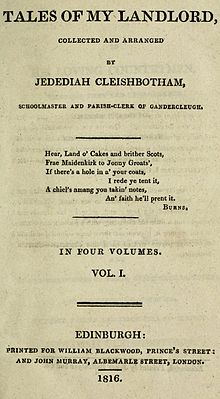Old Mortality

First edition title page
|
|
| Author | Sir Walter Scott |
|---|---|
| Country | Scotland |
| Language | English, Lowland Scots |
| Series | Tales of My Landlord (1st series) |
| Genre | Historical novel |
|
Publication date
|
1816 |
| Media type | Print (Hardback & Paperback) |
| ISBN | |
Old Mortality is a novel by Sir Walter Scott set in the period 1679–89 in south west Scotland. It forms, along with The Black Dwarf, the 1st series of Scott's Tales of My Landlord. The two novels were published together in 1816. Old Mortality is considered one of Scott's best novels.
It was originally titled The Tale of Old Mortality, but is generally shortened in most references.
After an Introduction to the Tales of My Landlord, supposedly written by the novel's (fictional) editor Jedediah Cleishbotham, an introduction by the author describes Robert Paterson, a Scotsman of the 18th century, who late in life decided to travel around Scotland re-engraving the tombs of 17th century Covenanter martyrs, and whom Scott met at Dunottar. In the first chapter of the novel Cleishbotham describes at length meeting Paterson, hearing his anecdotes, and finding other stories of the events to present an unbiased picture.
The novel then describes a wapenshaw held in 1679 by Lady Margaret Bellenden, life-rentrix of the barony of Tillietudlem. This was a show of her support for the Royalist cause, but most of her tenants favoured the opposing Covenanters (who wanted the re-establishment of presbyterianism in Scotland) and she has to enlist her unwilling servants. After her supporters are duly mustered, the main sport is a shoot at the popinjay in which the Cavalier favourite is narrowly defeated by Henry Morton, son of a Covenanter. He is introduced to Lady Margaret and her lovely granddaughter Edith Bellenden.
During celebrations of his popinjay victory in the inn that evening, Morton stands up for John Balfour of Burley against bullying by Cavalier dragoons. That night, Burley turns up uninvited at Morton's house and demands shelter. Morton reluctantly agrees, and it emerges that Burley was one of the assassins of Archbishop James Sharp. In the morning they have to flee Cavalier patrols. As a consequence, Morton finds himself outlawed, and joins Burley in the uprising at the Battle of Drumclog, at which group of around 200 armed Covenanters moved east, to a boggy moor near the farm of Drumclog. With about 40 mounted men, and armed with muskets and pitchforks, the Covenanter force was no rabble, and eventually charges round the edge of a bog or 'stank', routing the dragoons from the battlefield and leaving 36 dead. However, after this initial success, Scott traces the growth of factionalism, which hastened its defeat at the Battle of Bothwell Bridge in 1679, by forces led by the Duke of Monmouth and John Graham of Claverhouse.
...
Wikipedia
